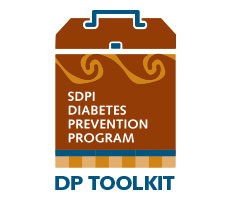Diabetes Prevention Program Toolkit
Archived: This Page Is No Longer Being Updated
This webpage is archived for historical purposes and is no longer being maintained or updated.
Module 3: DPP Implementation
Purpose To provide information on implementing the Diabetes Prevention Program (DPP) and to share strategies from SDPI Diabetes Prevention (DP) grant programs.
Background The original DPP clinical research study showed that people can achieve modest weight loss and reduce their risk for diabetes by participating in regular physical activity and making dietary changes. Lifestyle coaches were an important piece in overall participant success. They encouraged and supported participants to maintain lifestyle changes by teaching ways to overcome barriers to healthy eating and exercise.
DPP in American Indian/Alaska Native Communities The SDPI DP Program adapted the intensive lifestyle intervention used in the DPP research study in American Indian/Alaska Native (AI/AN) communities. SDPI grantees successfully implemented a version of the original DPP Lifestyle Balance curriculum, calling it "Native Lifestyle Balance," and tailored it to meet their community members' local culture and traditions.
Achievements of the SDPI DP Program included:
- Participants lost an average of nine pounds.
- More participants consumed healthy foods.
- More participants performed 150 minutes of exercise each week.
These positive outcomes encourage continued implementation of DPP programs in AI/AN communities.
DPP Implementation Today The DPP lifestyle intervention has shown successful outcomes over the years and continues to emphasize:
- Self-monitoring
- Self-efficacy
- Problem-solving
- Support from lifestyle coaches
- Tracking participant progress through weigh-ins
Participants are encouraged to keep track of their daily food intake and physical activity to help them meet the goals of:
- Weight loss: Lose at least 5% - 7% of their starting weight in the first six months
- Physical activity: Be active at least 150 minutes per week
In recent years, the Center for Disease Control and Prevention (CDC) established a Diabetes Prevention Recognition Program to prevent type 2 diabetes. Sites are encouraged to apply for recognition through the CDC's Diabetes Prevention Recognition Program to demonstrate that their DPP program meets certain standards set forth by the CDC. These standards include following an approved curriculum that is facilitated by a trained lifestyle coach and submitting data each year to show that the program is having an impact.
In this module, you will find keys to success for implementing a DPP program and strategies from SDPI DP grantees who have already successfully accomplished this in AI/AN communities.
Keys to Success
- The CDC-preferred curriculum can be found on the CDC National Diabetes Prevention Program Curricula and Handouts webpage.
- Programs may develop their own curriculum; however it should be evidence-based.
- If applying for CDC recognition, it must be evaluated by the CDC Diabetes Prevention Recognition Program to ensure that it meets all the key elements of the DPP research trial lifestyle curriculum.
- Session materials should be provided to all participants in an appropriate format (e.g., hard copy, electronic).
For more information on curricula, view resources from:
- SDPI DP Program:
- Module 3: DPP Implementation - Appendix (Curricula)
- CDC's National Diabetes Prevention Program:
The current DPP program is a year-long structured intervention in which participants learn how to make lifestyle changes to reduce their risk for type 2 diabetes.
Months 1 – 6
All 16 curriculum topics below should be covered in the first six months.
- Welcome to the DPP Program
- Self-Monitoring Weight and Food Intake
- Eating Less
- Healthy Eating
- Introduction to Physical Activity (Move Those Muscles)
- Overcoming Barriers to Physical Activity (Being Active – A Way of Life)
- Balancing Calorie Intake and Output
- Environmental Cues to Eating and Physical Activity
- Problem Solving
- Strategies for Healthy Eating Out
- Reversing Negative Thoughts
- Dealing with Slips in Lifestyle Change
- Mixing Up Your Physical Activity: Aerobic Fitness
- Social Cues
- Managing Stress
- Staying Motivated, Program Wrap Up
Months 7 – 12
At least one session should be offered in each of the six remaining months. Programs may elect to offer more sessions to participants needing additional support. Lifestyle coaches can choose which of the following topics to present and can do so in any order they wish.
- Welcome to the Second Phase of the Program
- Healthy Eating: Taking It One Meal at a Time
- Making Active Choices
- Balance Your Thoughts for Long-Term Maintenance
- Healthy Eating With Variety and Balance
- Handling Holidays, Vacations, and Special Events
- More Volume, Fewer Calories (Adding Water, Vegetables, and Fiber)
- Dietary Fats
- Stress and Time Management
- Healthy Cooking: Tips for Food Preparation and Recipe Modification
- Physical Activity Barriers
- Preventing Relapse
- Heart Health
- Life With Type 2 Diabetes
- Looking Back and Looking Forward
For more information on curricula, view resources from:
- SDPI DP Program:
- Module 3: DPP Implementation – Appendix (Curricula)
- CDC's National Diabetes Prevention Program:
- Native Lifestyle Balance Curriculum
The number of people that we got to complete the 16 sessions is amazing! The rapport that we build with our participants and then seeing how our participants pass on what they've learned to their family members, it is just spreading through the community.
Examples of adaptations to consider:
- Incorporate cultural stories and values.
- Translate the program name, session titles, or the entire curriculum, into the local Tribal language.
- Provide interpreters during sessions.
- Modify sessions to be culturally sensitive.
- Incorporate local traditional games, such as stickball.
- Focus on traditional foods and prepare them together.
- Provide calorie amounts and recipes for popular local foods.
- Develop strategies for eating more healthfully at local events.
- Offer a keepsake with traditional or Tribal meaning upon graduation from the DPP program.
Before the session:
- To optimize learning, ensure there is adequate staff to meet participants' needs and to foster successful program implementation.
- Allow participants to bring a support person to class so you can involve families whenever possible.
- Remind participants 1-2 days before each class.
During the session:
- Start sessions with an activity to make it more fun and engaging.
- Serve a light, healthy snack using traditional foods. Also use items and preparation tools you are recommending to participants in the program (e.g., measuring cups and spoons).
- Use visuals to show examples of healthy foods and how to do exercises correctly.
- Offer unique and fun activities.
Special session ideas:
- Incorporate interactive, hands-on activities such as:
- Food tastings in the classroom using healthy recipes and new food ideas.
- Grocery store tours to teach participants how to read nutrition labels and shop for healthy foods.
- Local field trips for fishing, berry picking, and greens picking.
- Teach a class in a local park when the weather is good.
- Invite speakers to present on different topics to keep classes lively and interesting, such as:
- Inspirational speakers.
- Dietitians to teach nutrition sessions or exercise specialists to teach physical activity sessions.
- Community champions who have been successful at making lifestyle changes.
- Hold a special session midway through the program and include family members.
- Include a discussion on ways to successfully handle the holidays or special occasions.
Partner with others in the community:
- Seek out individuals from the community to volunteer in your DPP program to assist with classes or help with recruitment (e.g., student interns from local colleges and universities).
- Participate in Tribal events, community-wide activities, and holiday events.
Communicate regularly with participants
- Provide easy access to lifestyle coaches.
- Send letters and cards (e.g., encouragement, birthday cards, class reminders).
- Distribute newsletters.
- Call participants who may have missed a class.
Promote success stories and shared experiences (with participants' permission)
- Create success posters.
- Conduct radio interviews.
- Write articles about participant success for local and Tribal newspapers and magazines.
Recognize participants' accomplishments
- Provide awards and certificates.
- Host graduation ceremonies.
- Consider involving your local Tribal leaders in honoring participants.
Identify and eliminate barriers to participation
- Consider providing transportation, child care, or other services to encourage participation.
Class scheduling strategies
- Be flexible in scheduling classes. Offer them at times that work for the participants including nights and weekends.
- Hold classes at participants' worksites, if needed (e.g., Tribal offices).
For more information on curricula, view resources from:
- SDPI DP Program:
- CDC's National Diabetes Prevention Program:
Take advantage of these free diabetes prevention and healthy lifestyle materials for American Indian and Alaska Native people:
- Self-print Materials (IHS Division of Diabetes) – Download and print educational materials.
- Education Materials and Resources (Online Catalog) (IHS Division of Diabetes) – Order educational materials at no cost.
- Physical Activity Kit (IHS Health Promotion/Disease Prevention) – Use the toolkit with ideas on physical activity in community settings.
- National Diabetes Education Program – Find clinical practice tools and patient education resources.
Lifestyle coaches can encourage participants to engage in self-care activities by meeting with each participant one-on-one during the DPP program.
- Coaching sessions are used to do the following:
- Assess participant needs.
- Individualize nutrition and physical activity plans to help participants meet their goals.
- Help with problem solving.
- Provide referral information (e.g., for tobacco cessation).
- Keys to lifestyle coaching success:
- Assign a coach to each DPP program participant.
- Identify and obtain training on coaching techniques and cultural sensitivity so that coaches develop effective relationships with participants.
- Use coaching techniques for behavior change and for overcoming barriers (e.g., listening, developing action plans, goal-setting, and motivational interviewing).
- Meet the participants where they are in the change process.
- Build a strong relationship with participants by being supportive and giving praise, feedback, and encouragement.
- Acknowledge any positive changes.
- Consider offering a different coach if the coach/participant relationship is not working out.
- Keep an open door policy for meeting with participants.
- For example, encourage participants to stop by when they are in the clinic or wellness center.
- Make appointments convenient for the participant, not the staff member. Coaches may need to meet on evenings or weekends and at the participant's home or workplace.
For more information on recruiting, view resources from:
- SDPI DP Program:
- CDC's National Diabetes Prevention Program:
Document session participation, individual coaching sessions, event participation, successes, barriers, and outcomes. This information will show which strategies and events were successful and help you assess progress toward your goals.
- To track participants' progress in the DPP program, baseline assessments should be completed at enrollment.
- CDC recognized programs need to submit data which includes participant demographic, height/weight, and diabetes risk information.
- For more information, see the Evaluation Data Elements provided in the CDC Diabetes Prevention Recognition Program Standards and Operating Procedures. [PDF]
For more information on enhancing program participation, view resources from:
- SDPI DP Program:
- CDC's National Diabetes Prevention Program:
- American Medical Association and CDC:
Lessons Learned
Case Study: Diabetes Prevention – The Navajo Way
Tuba City Diabetes Prevention Program
Tuba City, AZ
The Tuba City Diabetes Prevention (DP) team translated the DPP "Message of Hope" video and elements of the Native Lifestyle Balance sessions into Navajo, a challenging, but rewarding, accomplishment that was well-received throughout the community. Although not everything could be translated, the diabetes educators took a concept from each lesson, translated it into Navajo, and made it applicable to what people understand and what complements their core cultural beliefs.
As a result of their dedication and commitment, the Tuba City DP program saw successes that reached far beyond preventing diabetes. "It's been amazing to be part of this team and watch our participants set goals, make lifestyle changes, and gain confidence in other aspects of their life besides their health," said Preston Holiday, Project Coordinator. "Examples of confidence we've seen range from purchasing a car, to going back to graduate school, as well as improved family relationships among our participants."
The ability of the team to communicate and to understand the Navajo culture played an important role in their success. "Our participants feel really cared for and supported by an enthusiastic, knowledgeable, and caring group of people wanting them to succeed—it's pretty powerful," said Kristin Graziano, MD, Project Director.



